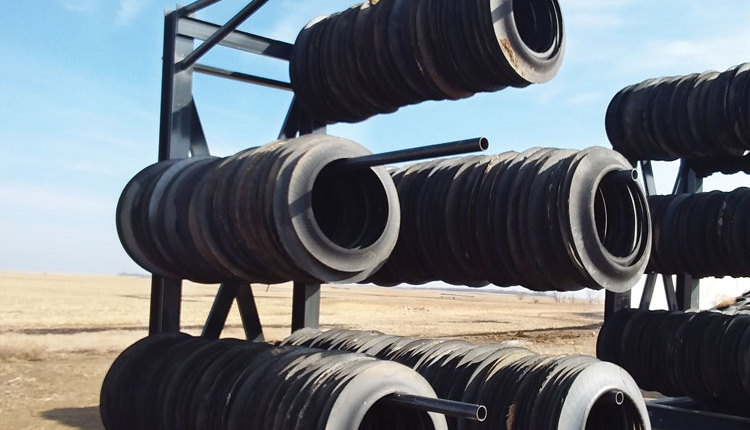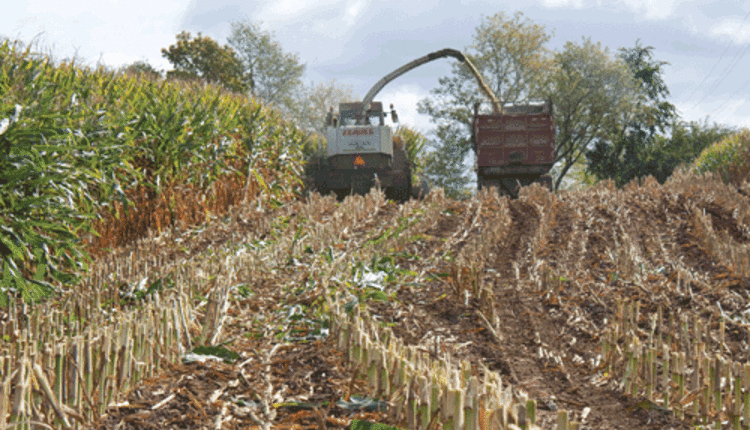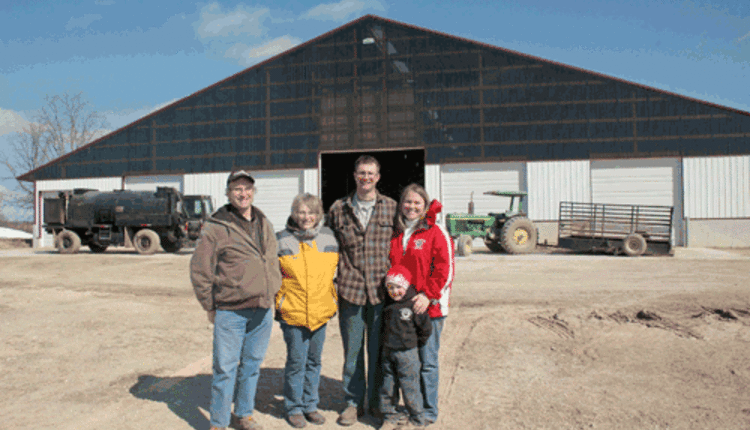The author is an agricultural free-lance writer based in Manitowoc County, Wis.
The goal of packing a bunker silo is to get high-quality feed in the smallest amount of space. Shape the pile correctly, blade thin layers, and use adequate tractor weight, says Lucas Vander Kinter (shown below).
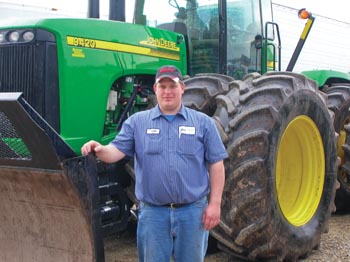
While packing a crop can sometimes take a backseat to the actual cutting or chopping of corn or hay, it can be costly when done poorly, says Lucas Vander Kinter. As dairies grow in size and the delivery rate of silage to bunkers and piles speeds up, it is critical to use enough packing tractors and take the time to get the desired minimum pack density, Vander Kinter says.
He operates Vander Kinter Farms, LLC, in partnership with his father, two uncles, and two brothers. Lucas' wife, Kathy, tends the book work, lines up drivers, and helps in the fields.
The Vander Kinters custom harvest over 30,000 acres of crops annually. The growing business uses a trio of choppers and handles fields across three counties in northeastern Wisconsin.
Although packing is generally considered the weakest link in harvesting corn or hay, Vander Kinter considers it a critical step in the service his family provides. The former milk producer knows poor packing can cause a pile to settle, resulting in dry matter loss.
The culprits are oxygen and bacteria. Low density packing means oxygen trapped in the pile. Bacteria use the trapped oxygen and burn energy in the form of dry matter. As bacteria grow and multiply, heating occurs and leads to spoilage which reduces overall silage yield. Dry matter loss can be greatly reduced by forcing as much oxygen as possible out of the pile before the bacteria can use it, Vander Kinter said.
The goal when packing is to get a lot of high-quality feed in the smallest amount of space. Vander Kinter targets a density of at least 17 pounds of dry matter per cubic foot for corn silage and at least 15 pounds of dry matter per cubic foot for hay silage. The higher the density, the better the silage, he added.
Five main factors . . .
Vander Kinter believes there are five main factors to consider in reaching those goals.
1. The shape of the pile heads his list. Piles should be filled from back to front, not from top to bottom, and should be in a wedge shape. Faster fill rates can be offset by spreading the increased amounts out in thin enough layers which can be provided by longer slopes.
2. The thickness of the layer is critical. Know the area you have to work with from the start, Vander Kinter advised, and blade thin layers of 6 inches or less to avoid too much air between layers and achieve a higher density.
3. Simply put, thinner layers pack more thoroughly than thicker layers, and anything that is over 6 inches makes maintaining high packing densities difficult. Adding more weight or packing more at the end of the day does not compensate for layers that are too thick, he warned.
4. Proper moisture and length of cut are also critical, as well as the rate at which the feed is being brought in. Sometimes adjustments are necessary. "Everything and everyone needs to coordinate to make sure this gets done right," Vander Kinter noted.
5. The fifth and biggest factor on his list is the number of tractors on the pile and their weight. Vander Kinter suggested dividing 18 by the weight of the tractor (in tons) to get the number of minutes of packing required per ton of wet silage.
For instance, his John Deere 9420 packing tractor weighs 55,000 pounds or 27.5 tons. Dividing 18 by 27.5 tons, he knows he'll be packing 0.65 minutes for each ton of wet feed.
Don't forget edges . . .
Watch the edges where density has a habit of lightening up as drivers avoid the walls, and keep the density tight and uniform as the pile grows in size. The top layer is particularly important as reduced density there promotes surface spoilage.
And as soon as the last load is packed, the bunker or pile should be covered and weighted down with tires. At one dairy, Vander Kinter noted, the employees are out covering the pile as soon as 60 feet has been packed.
For the Vander Kinters, the goal is a quality job and satisfied clients. "We want to do a good job, timely, well-done, and with no spoilage, so the dairy can feed every piece off the piles," he said.
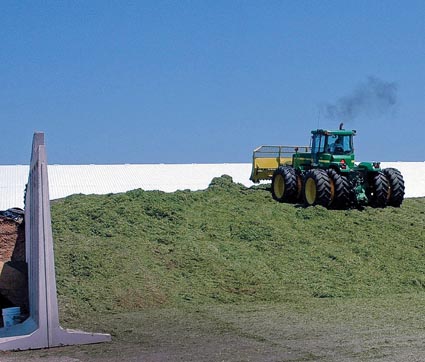
Click here to return to the Crops & Forages E-Sources
090525_366
The goal of packing a bunker silo is to get high-quality feed in the smallest amount of space. Shape the pile correctly, blade thin layers, and use adequate tractor weight, says Lucas Vander Kinter (shown below).

While packing a crop can sometimes take a backseat to the actual cutting or chopping of corn or hay, it can be costly when done poorly, says Lucas Vander Kinter. As dairies grow in size and the delivery rate of silage to bunkers and piles speeds up, it is critical to use enough packing tractors and take the time to get the desired minimum pack density, Vander Kinter says.
He operates Vander Kinter Farms, LLC, in partnership with his father, two uncles, and two brothers. Lucas' wife, Kathy, tends the book work, lines up drivers, and helps in the fields.
The Vander Kinters custom harvest over 30,000 acres of crops annually. The growing business uses a trio of choppers and handles fields across three counties in northeastern Wisconsin.
Although packing is generally considered the weakest link in harvesting corn or hay, Vander Kinter considers it a critical step in the service his family provides. The former milk producer knows poor packing can cause a pile to settle, resulting in dry matter loss.
The culprits are oxygen and bacteria. Low density packing means oxygen trapped in the pile. Bacteria use the trapped oxygen and burn energy in the form of dry matter. As bacteria grow and multiply, heating occurs and leads to spoilage which reduces overall silage yield. Dry matter loss can be greatly reduced by forcing as much oxygen as possible out of the pile before the bacteria can use it, Vander Kinter said.
The goal when packing is to get a lot of high-quality feed in the smallest amount of space. Vander Kinter targets a density of at least 17 pounds of dry matter per cubic foot for corn silage and at least 15 pounds of dry matter per cubic foot for hay silage. The higher the density, the better the silage, he added.
Five main factors . . .
Vander Kinter believes there are five main factors to consider in reaching those goals.
1. The shape of the pile heads his list. Piles should be filled from back to front, not from top to bottom, and should be in a wedge shape. Faster fill rates can be offset by spreading the increased amounts out in thin enough layers which can be provided by longer slopes.
2. The thickness of the layer is critical. Know the area you have to work with from the start, Vander Kinter advised, and blade thin layers of 6 inches or less to avoid too much air between layers and achieve a higher density.
3. Simply put, thinner layers pack more thoroughly than thicker layers, and anything that is over 6 inches makes maintaining high packing densities difficult. Adding more weight or packing more at the end of the day does not compensate for layers that are too thick, he warned.
4. Proper moisture and length of cut are also critical, as well as the rate at which the feed is being brought in. Sometimes adjustments are necessary. "Everything and everyone needs to coordinate to make sure this gets done right," Vander Kinter noted.
5. The fifth and biggest factor on his list is the number of tractors on the pile and their weight. Vander Kinter suggested dividing 18 by the weight of the tractor (in tons) to get the number of minutes of packing required per ton of wet silage.
For instance, his John Deere 9420 packing tractor weighs 55,000 pounds or 27.5 tons. Dividing 18 by 27.5 tons, he knows he'll be packing 0.65 minutes for each ton of wet feed.
Don't forget edges . . .
Watch the edges where density has a habit of lightening up as drivers avoid the walls, and keep the density tight and uniform as the pile grows in size. The top layer is particularly important as reduced density there promotes surface spoilage.
And as soon as the last load is packed, the bunker or pile should be covered and weighted down with tires. At one dairy, Vander Kinter noted, the employees are out covering the pile as soon as 60 feet has been packed.
For the Vander Kinters, the goal is a quality job and satisfied clients. "We want to do a good job, timely, well-done, and with no spoilage, so the dairy can feed every piece off the piles," he said.

090525_366





